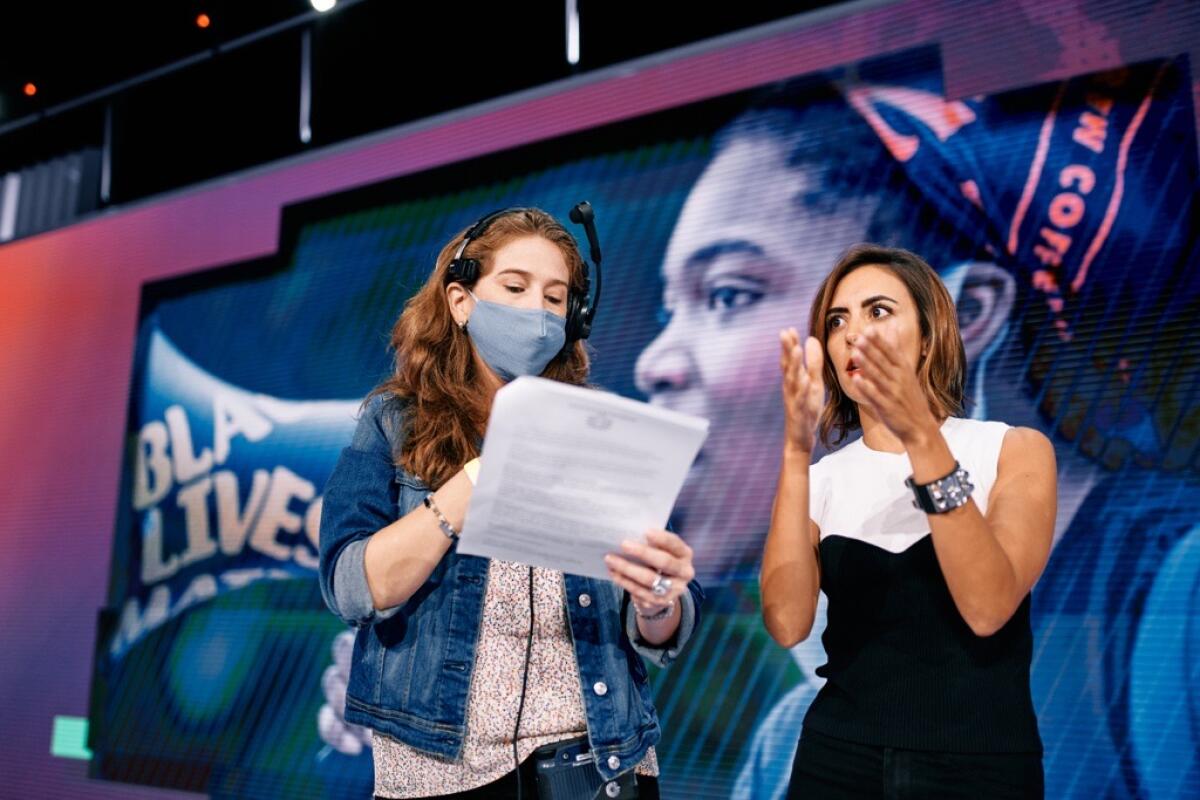Latinx Files: What will the future of Latinx television look like?

When Peter Murrieta’s show “Greetings From Tucson” premiered in the fall of 2002, he thought it was the beginning of a Latinx boom in television. His show, based on his own experience growing up, came months after the ABC premiere of “George Lopez,” another sitcom about a middle-class Mexican American family.
“I guess because I was a young writer then and I wrote my first pilot and it got shot, I just assumed that we were edging towards that kind of storytelling,” he said.
Nearly 20 years later, the promise of brown faces telling brown stories on prime-time TV remains unfulfilled, and it’s not hard to understand why.
“You’re in L.A, you’ve got to try not to hire Mexicans,” comedian Chris Rock wrote of Hollywood executives in a 2014 essay in the Hollywood Reporter.
It’s 2021 and the powers that be are still ignoring Latinx stories, choosing instead to take nostalgia programming and reheat it for high definition television. Just ask yourself: Who are reboots like “Roseanne,” “Mad About You” and “Sex and the City” for? “Roseanne” premiered more than 30 years ago (October 1988), which is older than the median age for Latinxs . Qué hueva.
The good news is that much has changed since then. Network television is no longer the end-all, be-all of small-screen entertainment.
“Obviously, we’re in a streaming world,” said Murrieta, who most recently was a co-executive producer for Netflix’s “Mr. Iglesias,” a sitcom starring comedian Gabriel “Fluffy” Iglesias, adding that the advent of streaming had forced him to reevaluate what success looks like.
The Latinx experience chronicled
Get the Latinx Files newsletter for stories that capture the multitudes within our communities.
You may occasionally receive promotional content from the Los Angeles Times.
“We’ve always collectively looked at getting a prime-time drama or sitcom as such a big accomplishment — all the while their viewership has been going down and down and down precipitously. And so I think you almost have to pick up your your tent poles and move on from that campground and just go, ‘OK, well, it didn’t happen here. So we’re going to go on elsewhere now.’”
Indeed, Netflix has done a much better job at telling Latinx stories with series such as “On My Block” and “Gentefied.” But it’s also gotten it wrong, displaying very little patience for shows with diverse casts that weren’t immediate successes and canceling them outright. “Ashley Garcia: Genius in Love,” a show that presented a new, positive archetype — the Latina genius — lasted only 15 episodes.
Interestingly enough, glimpses of what the future of Latinx television might look like can be found on Telemundo. Yes, really.
In 2020, the Spanish-centric network launched a YouTube news and commentary program called “Radar 2020” (Now “Radar 2021”) done in English hoping to court the same type of audience this newsletter is going after: bicultural, bilingual or English-dominant Latinxs based in the United States. The program is much lighter than your typical Telemundo news broadcast and covers topics rarely talked about on the network or elsewhere. The show has shined a light on racism and colorism within our culture, on queer Latinx identity and on how climate change disproportionately affects communities of color. An upcoming episode will be devoted entirely to equal pay for Latinas.

It makes sense that Telemundo would experiment with English-language programming. Studies have shown that the younger the Latinx, the more likely they are to be English-proficient or English-dominant, and given that nearly 6 in 10 Latinxs are millennials or younger, sticking to Spanish-only programming could prove to be an existential threat to the network.
“If you would have asked me a few years ago if I ever saw myself working at Telemundo, I would have said ‘Absolutely not,’” said host Gabriela Fresquez, who also co-writes the scripts. “I’m primarily English-speaking, and it was always the network that my parents or my tías would watch.”
Though “Radar 2021” is still in its infancy and working on building up its audience, the show has the full backing of network higher-ups, executive producer Grace González told me. “I think just getting people used to the fact that we’re doing something in English, coming from such a strong Spanish brand, is the hardest part.”
But if you really want to know what the future of Latinx television might be like, the best place to look for clues is everyone’s favorite video-sharing social network: TikTok.
The rise in popularity of TikTok should be taken seriously. In a July 2020 letter to shareholders, Netflix name-checked the app as one of its competitors, an acknowledgement that it’s as much a threat for audiences’ attention as Disney+. Pretty soon, the most-downloaded app of 2020 will also literally be television — Samsung recently announced that TikTok would come pre-installed in its smart TVs in the U.K. and has plans to expand to the rest of Europe.
The platform has been a boon for Latinx creators of all types. Folks like Adam Martinez (better known by his alter ego Rosa), Sienna Mae Gomez and the father-son duo of the Enkyboys (Ava DuVernay was so impressed by them that it’s said she wants to cast them in a project) have amassed millions of fans. Nathan Apodaca, better known as Doggface208, became an overnight sensation because of a TikTok video where he’s riding his longboard while listening to Fleetwood Mac’s “Dreams.” Such was the interest he garnered that my colleague Laura Zornoza’s profile of him was one of the most popular stories on our site last year.
(I promise you that I’m going to ask my colleague Gabby Fernandez to write the definitive guide to LatinoTok. But in writing this newsletter I learned of the work of Leo Gonzalez and Maya Murillo, became a fan and would highly recommend you follow them.)
These creators have grown massive followings organically because there aren’t any gatekeepers on that platform.
Murrieta, an admitted TikTok lurker, sees similarities between the TikTokers and Gabriel Iglesias, the star of his show.
“When you talk about the system, Gabriel wasn’t originally welcomed into it. He had to go out and build it all on his own. He created his own audience. In many ways, he was the precursor to what we’re seeing now.”
Consider subscribing to the Los Angeles Times
Your support helps us deliver the news that matters most. Become a subscriber.
“Radar 2021” host Gabriela Fresquez on what defines Latinx identity

“I think about this all the time. Sometimes I wake up and I have an identity crisis because ... what is it? Is it language? Well, my Spanish is not that great. Is it the immigrant factor? Well, my dad isn’t an immigrant, but my mom is. But what if they both weren’t? Would that make me less or more? Is my identity defined by the fact that my mom grew up in Mexico, or by our little cultural quirks?
I think for me it is the cultural quirks. It’s the songs we sing, the drinks we drink in the house, what we cook and what we eat. But, you know, language is a big part of that too. I joke about this, but when I do happy talk with my dog or when I do the baby voice, I speak to him in Spanish because he’s my baby. I’ll speak to him in Spanish because that’s the way my mom showed me affection growing up. I think it’s all of those little things coming together. What does it really boil down to? What makes me culturally unique or ethnically unique? I just think it’s not an easy thing to pin down.”
Meet our Latinx staff: Denise Florez
This week, I’ve asked my friend and colleague Denise Florez , a multiplatform editor, to write in her own words what she does. She didn’t mention it in her explanation, but in addition to what you will find below, you need to know that Denise was one of three people (along with my colleague Christian Orozco and myself) who digitized the 1983 Pulitzer Prize-winning series “Latinos.” She wrote about that experience here. Anyway, take it away, Denise!
I thought I would explain what a digital editor does, sort of showing a peek at what’s behind the online curtain. As my mom says when her friends ask her what I do, “pues muchas cosas.”
The primary function of my job is to make our journalism shine, to feature it in the best possible way online, to get the most eyes on it. I help plan the placement of stories, photos and video on the homepage, workshop headlines, make suggestions on what art will work, and talk to photo, video, audience engagement, product, copy and line editors about stories coming up.
Breaking news is another component of my work. If you have our news app on your phone, you might get notifications of breaking news popping up. Or if you get emails from breaking news, we also work on those. We work with the rest of the newsroom to decide what news needs to be shared with our readers right away.
One example in which my input as a Latina came into play was when Diego Maradona died. I knew how important he was to the world of fútbol. I was able to bring in some of my background to help make sure his story was placed prominently on latimes.com and also to workshop the headline. After a brief discussion, we took out some of the negative aspects from the headline — not because they weren’t true, but because it didn’t seem like his death was being treated the same as those of other famous people who also had drug problems or scandals but did not have that in their obituary headline.
I hope that gives some insight on the kind of work I do and that, yes, there are humans behind our website, not just algorithms.
The best thing on the Latinternet: Bad Bunny at WWE’s Royal Rumble
The biggest pop star in the world — Bad Bunny, baybeh! — lent his clout to WWE’s Royal Rumble, one of wrestling’s biggest nights. Not only did he perform “Booker T” in front of the legend himself, but the trap king did what every kid who grew up watching wrestling has dreamed of: He jumped from the top rope. You can watch his wrestling debut in its entirety here. My favorite part of the whole thing? Hearing him referred to as “Mr. Bunny.”
The Latinx experience chronicled
Get the Latinx Files newsletter for stories that capture the multitudes within our communities.
You may occasionally receive promotional content from the Los Angeles Times.




